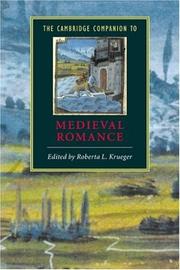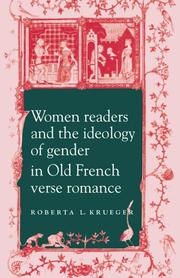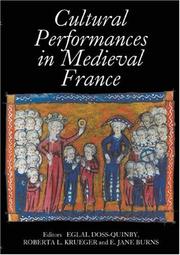| Listing 1 - 10 of 12 | << page >> |
Sort by
|

ISBN: 0521553423 0521556872 0511999283 1139815539 Year: 2000 Volume: *56 Publisher: Cambridge : Cambridge university press,
Abstract | Keywords | Export | Availability | Bookmark
 Loading...
Loading...Choose an application
- Reference Manager
- EndNote
- RefWorks (Direct export to RefWorks)
This Companion presents fifteen original and engaging essays by leading scholars on one of the most influential genres of Western literature. Chapters describe the origins of early verse romance in twelfth-century French and Anglo-Norman courts and analyze the evolution of verse and prose romance in France, Germany, England, Italy, and Spain throughout the Middle Ages. The volume introduces a rich array of traditions and texts and offers fresh perspectives on the manuscript context of romance, the relationship of romance to other genres, popular romance in urban contexts, romance as mirror of familiar and social tensions, and the representation of courtly love, chivalry, 'other' worlds and gender roles. Together the essays demonstrate that European romances not only helped to promulgate the ideals of elite societies in formation, but also held those values up for questioning. An introduction, a chronology and a bibliography of texts and translations complete this lively, useful overview.
Fiction --- anno 500-1499 --- Romances --- Literature, Medieval --- Roman courtois --- Littérature médiévale --- History and criticism. --- Histoire et critique --- 82 "04/14" --- 82-13 --- Literatuur. Algemene literatuurwetenschap--Middeleeuwen --- Epiek --- 82-13 Epiek --- 82 "04/14" Literatuur. Algemene literatuurwetenschap--Middeleeuwen --- Chivalric romances --- Chivalry --- Courtly romances --- French romances --- Medieval romances --- Romances, French --- Romans courtois --- French literature --- History and criticism --- Literature [Medieval ] --- Languages & Literatures --- Literature - General --- ROMANCES --- HISTORY AND CRITICISM

ISBN: 0521432677 Year: 1993 Volume: 43 Publisher: Cambridge : Cambridge university press,
Abstract | Keywords | Export | Availability | Bookmark
 Loading...
Loading...Choose an application
- Reference Manager
- EndNote
- RefWorks (Direct export to RefWorks)
This study focuses on the relationship between Old French verse romances and the women who formed a part of their audience, and challenges the commonly-held view that all courtly literature promoted the social welfare of the noblewomen to whom romances were dedicated or addressed. Using reader-response theory, feminist criticism and recent historical studies, Roberta Krueger provides close readings of a selection of texts, both well-known and less well-known, to show an intriguing variety of portrayals of women: misogynistic, idealizing and didactic. She suggests that romances not only taught their audiences idealized models of masculine and feminine behaviour (including a sophisticated underpinning of medieval women's loss of autonomy in the family, education and society during the twelfth and thirteenth centuries), but that many romances also invited their readers to criticise and to resist gender roles.
Poetry --- Old French literature --- Rôle selon le sexe dans la littérature --- Seksuele rolpatronen in de literatuur --- Sex role in literature --- 82:396 --- 840-1 "-/14" --- French poetry --- -Women --- -Women and literature --- -Romances --- -Sex role in literature --- Women --- -Human females --- Wimmin --- Woman --- Womon --- Womyn --- Females --- Human beings --- Femininity --- Chivalric romances --- Chivalry --- Courtly romances --- French romances --- Medieval romances --- Romances, French --- Romans courtois --- French literature --- Literature, Medieval --- Literature --- Literatuur en feminisme --- Franse literatuur: poëzie--?"-/14" --- History and criticism --- History --- -History --- Books and reading --- Romances --- Sex role in literature. --- Women and literature --- History and criticism. --- -Literatuur en feminisme --- 840-1 "-/14" Franse literatuur: poëzie--?"-/14" --- 82:396 Literatuur en feminisme --- -82:396 Literatuur en feminisme --- Human females --- To 1500 --- France --- Middle Ages, 500-1500 --- Women - France - History - Middle Ages, 500-1500. --- Women - France - Books and reading - History. --- Women and literature - France - History. --- Ecrivains et lecteurs --- Roman courtois français --- Poésie française --- Rôle selon le sexe --- Femmes --- Femmes et littérature --- Roman courtois --- Sexualité --- Dans la littérature --- Thèmes, motifs --- Avant 1500 --- Histoire et critique --- Livres et lecture --- Moyen-Age
Book
ISBN: 9781108749589 Year: 2023 Publisher: Cambridge : Cambridge university press,
Abstract | Keywords | Export | Availability | Bookmark
 Loading...
Loading...Choose an application
- Reference Manager
- EndNote
- RefWorks (Direct export to RefWorks)
Book
ISBN: 9780511999284 9780521553421 9780521556873 Year: 2000 Publisher: Cambridge Cambridge University Press
Abstract | Keywords | Export | Availability | Bookmark
 Loading...
Loading...Choose an application
- Reference Manager
- EndNote
- RefWorks (Direct export to RefWorks)

ISBN: 052161936X Year: 2005 Publisher: Cambridge Cambridge University press
Abstract | Keywords | Export | Availability | Bookmark
 Loading...
Loading...Choose an application
- Reference Manager
- EndNote
- RefWorks (Direct export to RefWorks)
French poetry --- Romances --- Sex role in literature --- Women and literature --- Women --- History and criticism --- History --- Books and reading
Book
ISBN: 1108802168 1108807674 1108783031 9781108802161 9781108807678 9781108783033 9781108479301 9781108749589 Year: 2023 Publisher: Cambridge ;New York, NY Cambridge University Press
Abstract | Keywords | Export | Availability | Bookmark
 Loading...
Loading...Choose an application
- Reference Manager
- EndNote
- RefWorks (Direct export to RefWorks)
This new Companion provides a broad and perceptive overview of the most important vernacular literary genre of the Middle Ages. Freshly commissioned, original chapters from seventeen leading scholars introduce students and general readers to the form's poetics, narrative voice and manuscript contexts, as well as its relationship to the Mediterranean world, race, gender and the emotions, among many other topics. Providing fresh perspectives on the first pan-European literary movement, essays range across a broad geographical area, including England, France, Italy, Germany and the Iberian Peninsula, as well as a varied linguistic spectrum, including Arabic, Hebrew and Yiddish. Exploring the celebration of chivalric ideals and courtly refinements, the volume excavates the tensions and traumas lying beneath decorous surface appearances. An introduction, bibliography of texts and translations as well as chapter-by-chapter reading lists complete this essential guide.
Literature, Medieval --- Romances --- History and criticism.
Article
Abstract | Keywords | Export | Availability | Bookmark
 Loading...
Loading...Choose an application
- Reference Manager
- EndNote
- RefWorks (Direct export to RefWorks)

ISBN: 9781846155291 9781843841128 1843841126 Year: 2007 Publisher: Suffolk Boydell & Brewer
Abstract | Keywords | Export | Availability | Bookmark
 Loading...
Loading...Choose an application
- Reference Manager
- EndNote
- RefWorks (Direct export to RefWorks)
Thematology --- French literature --- Performance art --- Littérature française --- Art de performance --- History and criticism. --- Histoire et critique --- Performance in literature
Book
ISBN: 9780812245868 0812245865 1322514097 0812209397 Year: 2014 Publisher: Philadelphia: University of Pennsylvania press,
Abstract | Keywords | Export | Availability | Bookmark
 Loading...
Loading...Choose an application
- Reference Manager
- EndNote
- RefWorks (Direct export to RefWorks)
Written in 1456 and purporting to be the biography of the actual fourteenth-century knight of its title, Jean de Saintré has been called the first modern novel in French and one of the first historical novels in any language. Taken in hand at the age of thirteen by an older and much more experienced lady, Madame des Belles Cousines, the youth grows into an accomplished knight, winning numerous tournaments and even leading a crusade against the infidels for the love of Madame. When he reaches maturity, Jean starts to rebel against Madame's domination by seeking out chivalric adventures on his own. She storms off to her country estates and takes up with the burly abbot of a nearby monastery. The text moves into darker and uncourtly territory when Jean discovers their liaison and lashes out to avenge his lost love and honor, ruining Madame's reputation in the process.Composed in the waning years of chivalry and at the threshold of the print revolution, Jean de Saintré incorporates disquisitions on sin and virtue, advice on hygiene and fashion, as well as lengthy set pieces of chivalric combat. Antoine de La Sale, who was, by turns, a page, a royal tutor, a soldier, and a judge at tournaments, embellished his text with wide-ranging insights into chivalric ideology, combat techniques, heraldry and warfare, and the moral training of a young knight. This superb translation—the first in nearly a hundred years—contextualizes the story with a rich introduction and a glossary and is suitable for scholars, students, and general readers alike. An encyclopedic compilation of medieval culture and a window into the lost world of chivalry, Jean de Saintré is a touchstone for both the late Middle Ages and the emergence of the modern novel.
Saintré, Jehan de, --- Saintré, Jehan de, --- Saintre, Jehan de, --- History. --- Medieval and Renaissance Studies. --- HISTORY / Medieval.

ISBN: 1282185268 9786612185267 1846155290 1843841126 9781843841128 Year: 2007 Publisher: Woodbridge: Brewer,
Abstract | Keywords | Export | Availability | Bookmark
 Loading...
Loading...Choose an application
- Reference Manager
- EndNote
- RefWorks (Direct export to RefWorks)
This collection of essays pays tribute to Nancy Freeman Regalado, a ground-breaking scholar in the field of medieval French literature whose research has always pushed beyond disciplinary boundaries. The articles in the volume reflect the depth and diversity of her scholarship, as well as her collaborations with literary critics, philologists, historians, art historians, musicologists, and vocalists - in France, England, and the United States. Inspired by her most recent work, these twenty-four essays are tied together by a single question, rich in ramifications: how does performance shape our understanding of medieval and pre-modern literature and culture, whether the nature of that performance is visual, linguistic, theatrical, musical, religious, didactic, socio-political, or editorial? The studies presented here invite us to look afresh at the interrelationship of audience, author, text, and artifact, to imagine new ways of conceptualizing the creation, transmission, and reception of medieval literature, music, and art.
EGLAL DOSS-QUINBY is Professor of French at Smith College; ROBERTA L. KRUEGER is Professor of French at Hamilton College; E. JANE BURNS is Professor of Women's Studies and Adjunct Professor of Comparative Literature at the University of North Carolina, Chapel Hill.
Contributors: ANNE AZÉMA, RENATE BLUMENFELD-KOSINSKI, CYNTHIA J. BROWN, ELIZABETH A. R. BROWN, MATILDA TOMARYN BRUCKNER, E. JANE BURNS, ARDIS BUTTERFIELD, KIMBERLEE CAMPBELL, ROBERT L. A. CLARK, MARK CRUSE, KATHRYN A. DUYS, ELIZABETH EMERY, SYLVIA HUOT, MARILYN LAWRENCE, KATHLEEN A. LOYSEN, LAURIE POSTLEWATE, EDWARD H. ROESNER, SAMUEL N. ROSENBERG, LUCY FREEMAN SANDLER, PAMELA SHEINGORN, HELEN SOLTERER, JANE H. M. TAYLOR, EVELYN BIRGE VITZ, LORI J. WALTERS, AND MICHEL ZINK.
| Listing 1 - 10 of 12 | << page >> |
Sort by
|

 Search
Search Feedback
Feedback About UniCat
About UniCat  Help
Help News
News